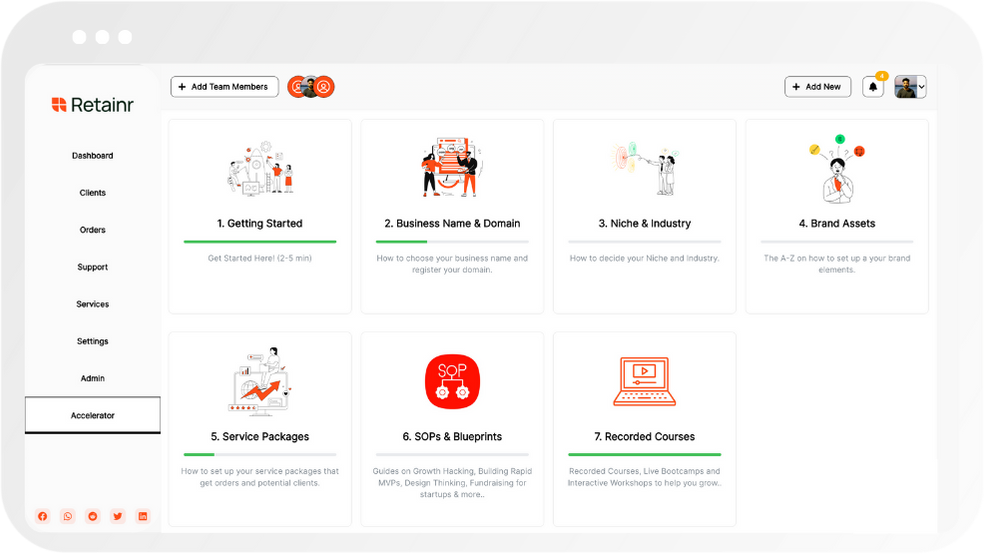
10 Tips for Conducting Productive Virtual Meetings
Build with Retainr
Sell your products and services, manage clients, orders, payments, automate your client onboarding and management with your own branded web application.
Get Started1. What are the top 10 tips for conducting productive virtual meetings?
Preparation and Planning
Before any productive virtual meeting, adequate preparations should be made. This may include:
- Create an agenda: determine the purpose of the meeting, what needs to be discussed, and who should be in attendance.
- Choose a reliable platform: there are numerous virtual meeting platforms to select from like Zoom, Microsoft Teams or Google Meet. Choose one based on your company's needs and preferences, and make sure it's reliable.
- Send invites in good time: ensure all participants are given enough time to prepare for the meeting and mark it on their calendar.
During the Meeting
Productive virtual meetings are characterized by efficient and effective use of time, respectful communication, and active participation. Some tips include:
| Respect start and end times: | Begin the meeting promptly and end it at the agreed time. |
| Encourage active participation: | Make sure that all participants have the chance to contribute to the discussion. |
| Communicate clearly: | Express ideas and issues clearly and concisely to avoid misunderstandings. |
Post-Meeting Procedures
Even after the virtual meeting has concluded, there are steps that need to be taken to ensure overall productivity:
- Provide minutes of the meeting: It is important to circulate minutes detailing what was discussed, decisions made and actions to be taken.
- Obtain feedback: Make sure participants can share their feedback. This will help identify areas requiring improvement.
- Follow-up on actions: Delegating tasks is inefficient if follow-ups are not done. Therefore, track the progress of actions taken to ensure completion.
2. How can I make my virtual meetings more productive?
Preparation is Key
Preparation plays a pivotal role in making virtual meetings productive. First and foremost, make sure you have a stable internet connection to avoid disruption during the meeting. Test your equipment, such as the webcam and microphone, prior to the meeting. It's also important to prepare an agenda and share it with the participants ahead of the meeting. This helps everyone know what to expect and come prepared, resulting in more focused discussions.
| Preparation Steps | Importance |
|---|---|
| Stable internet connection | Prevents unnecessary disruptions |
| Test equipment | Ensures seamless communication |
| Prepare and share agenda | Promotes focused discussions |
Engagement and Participation
Keeping the participants engaged and ensuring their active participation is another crucial aspect. Encourage all attendees to turn their cameras on to create a more inclusive environment. You can also start the meeting with a brief ice-breaker activity to create a relaxed atmosphere. Ensure diversity in opinion by giving everyone a chance to speak. Utilize features like polls or whiteboards that most virtual meeting platforms offer to make the meeting interactive.
- Encourage use of video
- Start with an Ice-Breaker
- Give everyone a chance to speak
- Use interactive features
Time Management
Effective time management is crucial for productivity. Stick to the meeting's set timing and ensure the discussion stays on the agenda's topics. Take short breaks if the meeting is long to prevent fatigue and maintain productivity. It's also a good practice to assign a specific time for Q&A or feedback towards the end of the meeting.
- Adhere to set timing
- Keep discussion topic-focused
- Take short breaks for long meetings
- Arrange Q&A or feedback session
3. How can I keep participants engaged during a virtual meeting?
Set Clear Objectives and Agenda
To keep participants actively involved in a virtual meeting, it's crucial to establish clear objectives and an agenda. State the purpose of the meeting upfront and provide an agenda beforehand so that everyone knows what to expect, preventing potential distractions and disengagements.
- Use a simple descriptive title for the meeting.
- Divide the meeting into manageable sections.
- Allocate specific time slots for each section.
Promote Interaction and Participation
Promoting interaction and participation is a key factor in keeping attendees engaged during a virtual meeting. The more involved people are, the less likely they are to zone out. You can use different techniques to increase participation, such as posing questions, conducting polls, or using collaborative tools where everyone can add their inputs.
| Technique | Explanation |
| Pose questions | Ask open-ended questions to stimulate discussion. |
| Conduct polls | Make use of online polling tools to gather opinions quickly. |
| Use collaborative tools | Involve team members in activities such as brainstorming using collaborative virtual whiteboards or documents. |
Leverage Visuals and Interactive Elements
In a virtual setting, visuals play a critical role in maintaining the interest of participants. Charts, infographics, and videos can make the presentation more engaging. Besides, encourage everyone to use their video to foster a sense of connection and collaboration. These visual and interactive measures significantly help to maintain the attention and involvement of attendees throughout your virtual meeting.
- Use charts and infographics to support your key points.
- Integrate videos where possible for a more dynamic meeting.
- Encourage the use of video to make the meeting more personal and interactive.
4. What perspectives should I keep in mind to accommodate different time zones in virtual meetings?
Understanding Time Zones
The first step in accommodating various time zones in virtual meetings is understanding the geographical locations of your attendees. User-friendly tools like World Time Buddy or Timeanddate's Meeting Planner can help you visualize the overlapping working hours for different locations. Working across time zones particularly between the east and west can be tricky due to significant differences, but try to find a time that works best for everyone.
- Consider alternating meeting times to ensure fairness. Don’t burden one party by constantly making them adjust their schedule.
- Be mindful of the local holidays and weekends that might differ across countries.
- Record the meeting for those who can’t attend due to time zone differences.
Communicate Clearly and Respectfully
When scheduling, clearly communicate the time and date of the meeting along with the time zone. When working with international teams, it’s best to use Coordinated Universal Time (UTC±0) to avoid confusion. Also, consider using 24-hour format to eliminate AM/PM confusion. It's crucial to inform participants about any changes in the meeting time well in advance, giving them enough time to adjust their schedule if necessary.
Choosing the Right Tools
Choosing the right tools can help to bridge the gap across time zones. Use a scheduling tool that shows time zones or tries to find the best meeting time across time zones for you. Once the meeting is set, use a shared calendar or meeting invitations that automatically adjust the meeting time in each recipient’s calendar according to their time zone.
| Tool | Purpose |
|---|---|
| World Time Buddy / Timeanddate's Meeting Planner | For understanding and visualizing time zones |
| Google Calendar / Outlook | For sending meeting invitations that adjust as per the recipient’s time zone |
| Doodle / Calendly | For finding the best meeting time across time zones |
5. Are there any specific platforms recommended for hosting productive virtual meetings?
Recommended Platforms for Virtual Meetings
There are a plethora of robust virtual meeting platforms that can be instrumental in fostering productive remote discussions. Each platform has its unique set of features that suit different types of meetings and industry requirements. However, there are a few standout platforms that consistently rank high in terms of reliability, ease of use, and features that promote effective communication.
- Zoom: Zoom offers an intuitive and user-friendly interface, high-quality video and audio, and a variety of features such as screen sharing, breakout rooms, and recording options. It's suitable for both small-group collaborations and large-scale webinars.
- Microsoft Teams: If your organization heavily relies on Office 365, then Microsoft Teams might be the best option. It offers seamless integration with other Microsoft products, making it easier to share documents and collaborate.
- Google Meet: For those who rely on G Suite, Google Meet offers a secure and reliable platform that integrates well with Google Calendar, Gmail, and Google Docs. It's also one of the more affordable options.
- Slack: Renowned for its instant messaging capabilities, Slack also offers voice and video calls. Though it might not have as many features as other platforms, its simplicity and integration with other services make it a strong contender.
- Cisco Webex: Cisco Webex is a great choice for large enterprises, mainly due to its robust security measures and deep-seated features. It also integrates well with a range of apps and services.
In addition to the above, the following table summarizes additional platforms that are worth considering:
| Platform | Key Feature |
|---|---|
| Skype | Popular for its free version offering reasonable call quality and screen sharing |
| GoToMeeting | Offers a professional-grade conferencing tool with a variety of packages suited for different meeting sizes |
| Adobe Connect | Offers versatility, being good for webinars, meetings, and virtual classrooms |
6. Can you provide some tips on how to structure an agenda for a virtual meeting?
Preparation of a Structured Agenda
For successful virtual meetings, an effective, well-structured agenda is indispensable. It guides the flow of the meeting, ensuring all vital points are addressed keeping everyone on track. There are several tips to consider when structuring a virtual meeting agenda.
First and foremost, Identify your Aim. Determine what you intend to accomplish in the meeting, and define the objectives. These could be making a decision, brainstorming ideas, or discussing project progress. Secondly, Highlight Key Topics. Break your objectives into specific, manageable topics. Start with the most important or urgent issues, to ensure they're addressed while attendees are most alert. Thirdly, Allocate Time Slots. Each topic should have a specific time slot associated with it. This prevents discussions from dragging out. But also be sure to be flexible; some topics might require a bit more time than planned.
| Agenda Order | Agenda Items | Discussion Time | Person Responsible |
|---|---|---|---|
| 1 | Identify Aim | 10 Minutes | All Participants |
| 2 | Highlight Key Topics | 15 Minutes | Meeting Leader |
| 3 | Allocate Time Slots | 15 Minutes | Meeting Leader |
Finally, assign roles. A meeting facilitator ensures discussions stay on track, a note-taker captures key points, and an IT specialist troubleshoots any technical issues. Clearly indicate who's responsible for each topic, and send out the agenda at least 24 hours prior to the meeting. This allows attendees to come prepared, making your virtual meeting more focused and productive.
7. How can I deal with technical difficulties that may arise during a virtual meeting?
Preparation to Handle Technical Difficacies
Before the meeting starts, prepare a list of possible technical difficulties that may occur and outline the solutions for each. It includes issues like network disruption, software malfunction, microphone issues, and more. Keep this guide readily available so you can quickly refer to it if need be.
- Network disruption: Reconnect to the network or switch to a more stable connection.
- Software malfunction: Familiarize yourself with the software's troubleshooting guide in advance.
- Microphone issues: Ensure your microphone is properly connected and functioning before starting the meeting.
During the Meeting
Even with comprehensive preparation, issues may still arise during the meeting. Be patient and address each problem as it comes. Here's a list of actions you could take:
- If a participant can't connect, advise them to check their internet and reboot their device if necessary.
- For audio issues, suggest plugging in headphones or connecting to a Bluetooth speaker.
- Share a user guide or other supportive materials with participants if they're struggling with the software.
Having a Backup Plan
| Backup Plan | Sheets-route |
|---|---|
| Dial-in Option | If internet connectivity is a problem, provide a dial-in option so participants can join via phone call. |
| Backup Device | Have another device ready that you can switch to if your current one malfunctions. |
| Record the Meeting | In case someone misses the meeting due to technical issues, record the meeting so they can catch up later. |
8. How can I effectively communicate and assign tasks during a virtual meeting?
Effective Communication During Virtual Meetings
Effective communication during virtual meetings is crucial for achieving meeting outcomes. There are some key points that can help ensure productive communication. First, it's essential to speak clearly and concisely to prevent misunderstandings. Advanced preparation to keep the discussion on track is also crucial. Visual aids like slides or documents shared on screen can make the communication more effective. It’s important to ask proactively for responses to make sure everyone understands and agrees on the points.
- Speak clearly and concisely
- Prepare and have a clear agenda
- Use visual aids
- Ask for feedback and responses
Assigning Tasks During Virtual Meetings
Assigning tasks during virtual meetings can be a bit challenging without the right approach. One effective method is to use a shared document or project management tool that everyone can view and update. Tasks should be assigned clearly, specifying the responsible person, deadline, and expected outcome. Follow-ups are to ensure the assigned tasks are being carried out and to provide necessary assistance.
| Task | Assignee | Deadline | Expected Outcome |
|---|---|---|---|
| Task A | Person 1 | 01/01/2022 | Outcome A |
| Task B | Person 2 | 02/01/2022 | Outcome B |
Ensure to mark tasks as completed after they are done. This will help track progress and quickly understand what's left to do. It’s also beneficial to recognize and appreciate the efforts of team members, as this motivates them for future tasks.
9. Can you suggest any strategies to promote participation and prevent one-sided discussions in a virtual meeting?
Promote Engagement
Promoting participation and facilitating multi-dimensional discussion start with creating an environment conducive to engagement. Firstly, encourage an open, respectful and non-judgmental atmosphere for communication. Smooth and open forums encourage healthy conversation and prevent one-sided discussions. Secondly, use interactive tools and features to engage participants. Most virtual meeting platforms have polling features and Q&A sections that can help stimulate conversation and participation.
- Arrange breakout rooms for smaller group discussions
- Regular use of polling to gather participant feedback
- Utilize virtual whiteboards to encourage collaborative problem-solving
Prevent One-sided Discussions
To avoid a unilateral conversation, establish some ground rules at the start of the meeting. Make it clear that everyone's opinion is valuable and should be heard. To make discussions more balance, it's necessary to assign someone as a moderator to manage the speaking turns. During the discussion, the moderator can see if someone is dominating the conversation and redirect the discussion accordingly. Keep track of who is participating and invite quieter members to share their ideas.
| Strategy | Description |
|---|---|
| Establish Ground Rules | At the start of the meeting, establish rules to ensure everyone has an opportunity to share thereby making the discussion multidimensional |
| Assign a Moderator | A moderator can manage speaking turns and redirect the conversation if someone is dominating |
| Track Participation | Keep an eye on who's contributing and invite quieter members to share their thoughts |
Final Words
Creating a healthy, interactive forum during virtual meetings is vital to ensure a productive session, all ideas are heard, and solutions brainstormed. Implementing these strategies will result in better engagement and prevent one-sided discussions.
10. How can I make sure all participants understand the content and goals of the virtual meeting?
Clarify Meeting Objectives and Agenda
To ensure all participants understand the purpose and goals of the virtual meeting, it is necessary to clarify and communicate them effectively. Begin by stating the meeting objectives succinctly. Then, provide a detailed agenda. This should outline the items to be discussed, the person responsible for each item, and the time allocated for each topic. Send this to all participants ahead of the meeting.
Seek Participation and Engagement
One way to ensure participants understand the content and goals is by seeking their active participation and engagement. Present your content in a compelling manner, encourage questions, and foster discussions. Some techniques include:
- Using interactive elements such as polls or quizzes
- Encouraging participants to share their thoughts and ideas
- Asking thought-provoking questions to stimulate discussion
- Inviting participants to present on sub-topics if appropriate
Post-Meeting Follow-up
A disciplined post-meeting follow-up is another effective way to confirm participants' understanding. You can:
- Send out meeting minutes promptly: Capture key decisions, action items, and responsible persons in a structured format.
- Conduct a quick survey: Ask participants about their most important takeaways from the meeting, and any areas they found unclear. This will give you a sense of whether the meeting's content and goals were understood.
- Schedule a follow-up meeting: If some points require further clarification, a follow-up meeting can be a good way to ensure everyone is on the same page.
Conclusion
Unlock the secrets to effective virtual meetings
Conducting productive virtual meetings can pose a unique set of challenges. From facilitating open communication to ensuring tasks are actioned post-meeting, taking your meetings online requires a tailored approach. We reveal ten key tips to help you maximise productivity in your virtual gatherings.
1. Set clear objectives
Avoid ambiguity and ensure all participants understand what the meeting aims to achieve. This will prevent veering off topic and help maintain focus.
2. Determine the necessity
Avoid overwhelming your team with unnecessary meetings. Before scheduling, decide if the issue can be addressed via email or collaborative task management software, like retainr.io.
3. Use engaging tools
Improve engagement and interactivity by incorporating multimedia elements or collaborative tools such as virtual whiteboards.
4. Limit numbers
Keep your list of participants minimal to ensure every voice is heard. Large groups in a virtual setting can often limit productive conversation.
5. Assign roles
Designate a meeting leader to navigate the conversation and a note taker to record important points.
6. Encourage participation
Actively involve all participants, facilitating open discussions to encourage a collaborative environment.
7. Follow an agenda
A clear, concise meeting agenda is crucial. This helps to manage the meeting's direction, ensuring all key points are addressed.
8. Keep to time
Respecting participants' time strengthens relationships and increases productivity. Start and end meetings punctually to help maintain focus.
9. Manage follow up actions
Ensure all follow up tasks are clear, allocated and actioned. Tools like retainr.io can help manage post-meeting tasks and assignments effectively.
10. Request feedback
Constructive feedback can help improve future meetings. Invite comments on what worked well and what can be improved.
The challenges of virtual meetings shouldn't be a barrier to productivity. Utilise these tips to make your gatherings more effective and consider using our whitelabel software retainr.io to easily manage clients, orders and payments with your own branded app. Take control of your virtual sessions and let retainr.io handle the rest.
Boost Your Agency Growth
with Retainr Accelerator
Uncover secrets, strategies, and exclusive blueprints to take your agency's growth to the next level — from marketing insights to effective presentations and leveraging technology.

SOPs, Cheatsheets & Blueprints
Leverage 50+ SOPs (valued over $10K) offering practical guides, scripts, tools, hacks, templates, and cheat sheets to fast-track your startup's growth.
Connect with fellow entrepreneurs, share experiences, and get expert insights within our exclusive Facebook community.
.jpg)

Join a thriving community of growth hackers. Network, collaborate, and learn from like-minded entrepreneurs on a lifelong journey to success.

Gain expertise with recorded Courses, Live Bootcamps and interactive Workshops on topics like growth hacking, copywriting, no-code funnel building, performance marketing and more, taught by seasoned coaches & industry experts.

.jpg)

.jpeg)


